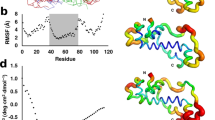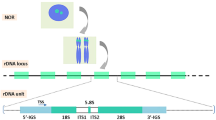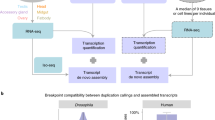Abstract
PSEUDOGENES are common in mammals but virtually absent in Drosophila1. All putative Drosophila pseudogenes show patterns of molecular evolution that are inconsistent with the lack of functional constraints2–5. The absence of bona fide pseudogenes is not only puzzling, it also hampers attempts to estimate rates and patterns of neutral DNA change. The estimation problem is especially acute in the case of deletions and insertions, which are likely to have large effects when they occur in functional genes and are therefore subject to strong purifying selection. We propose a solution to this problem by taking advantage of the propensity of retrotransposable elements without long terminal repeats (non-LTR) to create non-functional, 'dead-on-arrival' copies of themselves as a common by-product of their transpositional cycle6–8. Phylogenetic analysis of a non-LTR element, Helena, demonstrates that copies lose DNA at an unusually high rate, suggesting that lack of pseudogenes in Drosophila is the product of rampant deletion of DNA in unconstrained regions. This finding has important implications for the study of genome evolution in general and the 'C-value paradox'9 in particular.
This is a preview of subscription content, access via your institution
Access options
Subscribe to this journal
Receive 51 print issues and online access
$199.00 per year
only $3.90 per issue
Buy this article
- Purchase on Springer Link
- Instant access to full article PDF
Prices may be subject to local taxes which are calculated during checkout
Similar content being viewed by others
References
Weiner, A. M., Deininger, P. L. & Efstratiadis, A. Annu. Rev. Biochem. 55, 631–661 (1986).
Currie, P. D. & Sullivan, D. T. Genetics 138, 353–363 (1994).
Sullivan, D. T., Starmer, W. T., Curtis, S. W., Menotti-Raymond, M. & Yum, J. Mol. Biol. Evol. 11, 443–458 (1994).
Long, M. Y. & Langley, C. H. Science 260, 91–95 (1993).
Jeffs, P. & Ashburner, M. Proc. R. Soc. Lond. B 244, 151–159 (1991).
Finnegan, D. J. in Mobile DNA (eds Berg, D. E. & Howe, M. M.) 503–517 (Am. Soc. Microbiol., Washington DC, 1989).
Hutchison, C. A. III, Hardies, S. C., Loeb, D. D., Shehee, W. R. & Edgell, M. H. in Mobile DNA (eds Berg, D. E. & Howe, M. M.) 593–617 (Am. Soc. Microbiol., Washington DC, 1989).
Luan, D. D., Korman, M. H., Jacubczak, J. L. & Eickbush, T. H. Cell 72, 595–605 (1993).
John, B. & Miklos, G. The Eukaryote Genome in Development and Evolution (Allen & Unwin, London, 1988).
McClure, M. in Reverse Transcriptase (eds Skalka, A. M. & Goff, S. P.) (Cold Spring Harbor Laboratory Press, New York, 1993).
Petrov, D. A., Schutzman, J. L., Hartl, D. L. & Lozovskaya, E. R. Proc. Natl Acad. Sci. USA 92, 8050–8054 (1995).
Swofford, D. L. PAUP: Phylogenetic Analysis Using Parsimony Version 3.0s (Illinois Natural History Survey, Champaign, 1991).
Springer, M. S., Tusneem, N. A., Davidson, E. H. & Britten, R. J. Mol. Biol. Evol. 12, 219–230 (1995).
Eickbush, D. G., Lathe, W. C., Francino, M. P. & Eickbush, T. H. Genetics 139, 685–695 (1995).
Bebenek, K. & Kunkel, T. A. in Reverse Transcriptase (eds Skalka, A. M. & Goff, S. P.) (Cold Spring Harbor Laboratory Press, New York, 1993).
Graur, D., Shuali, Y. & Li, W.-H. J. Mol. Evol. 28, 279–285 (1989).
Jones, C. W. & Kafatos, F. C. J. Mol. Evol. 19, 87–103 (1982).
Levinson, G. & Gutman, G. Mol. Biol. Evol. 4, 203–221 (1987).
Sharp, P. M. & Li, W.-H. J. Mol. Evol. 28, 398–402 (1989).
deSouza, S. J., Long, M. & Gilbert, W. Genes to Cells 1, 493–505 (1996).
Hughes, A. L. & Hughes, M. K. Nature 377, 391 (1995).
Strathmann, M. et al. Proc. Natl Acad. Sci. USA 88, 1247–1250 (1991).
Maddison, W. P. & Maddison, D. R. MacClade Version 3 (Sinauer Associates, Sunderland, Massachusetts, 1992).
Author information
Authors and Affiliations
Rights and permissions
About this article
Cite this article
Petrov, D., Lozovskaya, E. & Hartl, D. High intrinsic rate of DNA loss in Drosophila. Nature 384, 346–349 (1996). https://doi.org/10.1038/384346a0
Received:
Accepted:
Issue Date:
DOI: https://doi.org/10.1038/384346a0
This article is cited by
-
Mitochondrially mediated RNA interference, a retrograde signaling system affecting nuclear gene expression
Heredity (2023)
-
On the possibility of death of new genes – evidence from the deletion of de novo microRNAs
BMC Genomics (2018)
-
Genome-wide variation in recombination rate in Eucalyptus
BMC Genomics (2016)
-
Ancestral whole-genome duplication in the marine chelicerate horseshoe crabs
Heredity (2016)
-
Correlated expression of retrocopies and parental genes in zebrafish
Molecular Genetics and Genomics (2016)
Comments
By submitting a comment you agree to abide by our Terms and Community Guidelines. If you find something abusive or that does not comply with our terms or guidelines please flag it as inappropriate.



